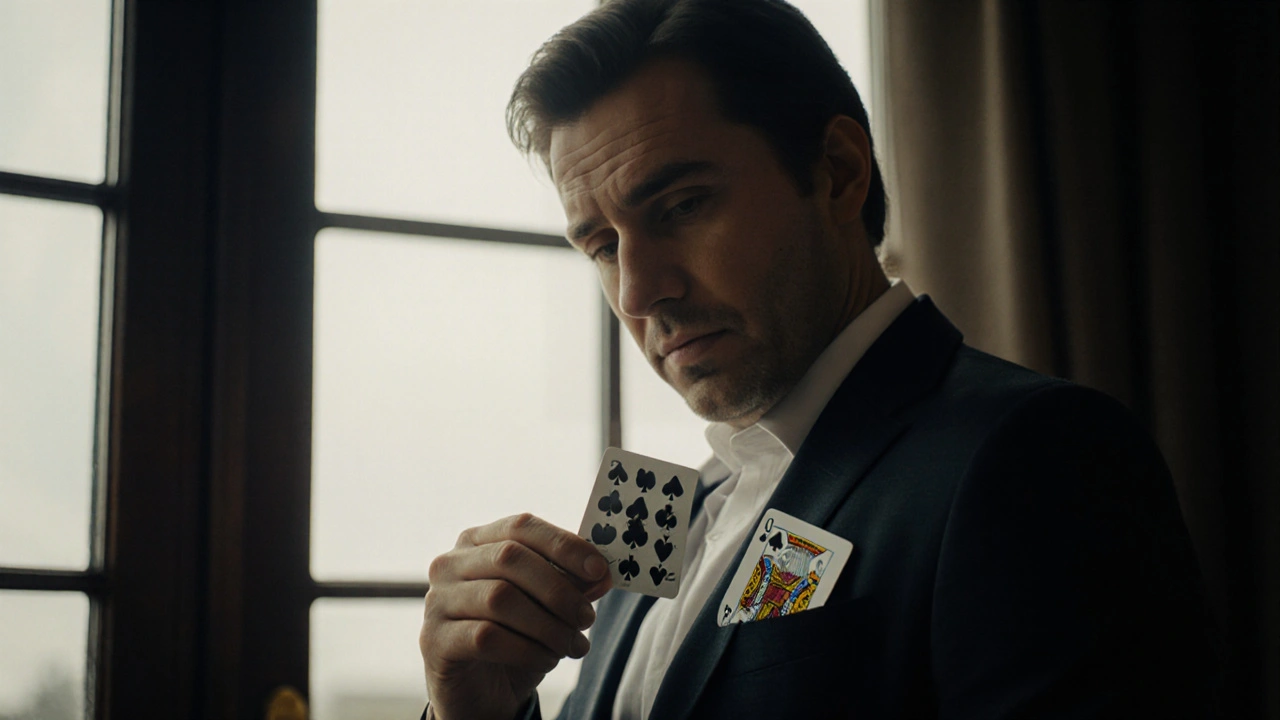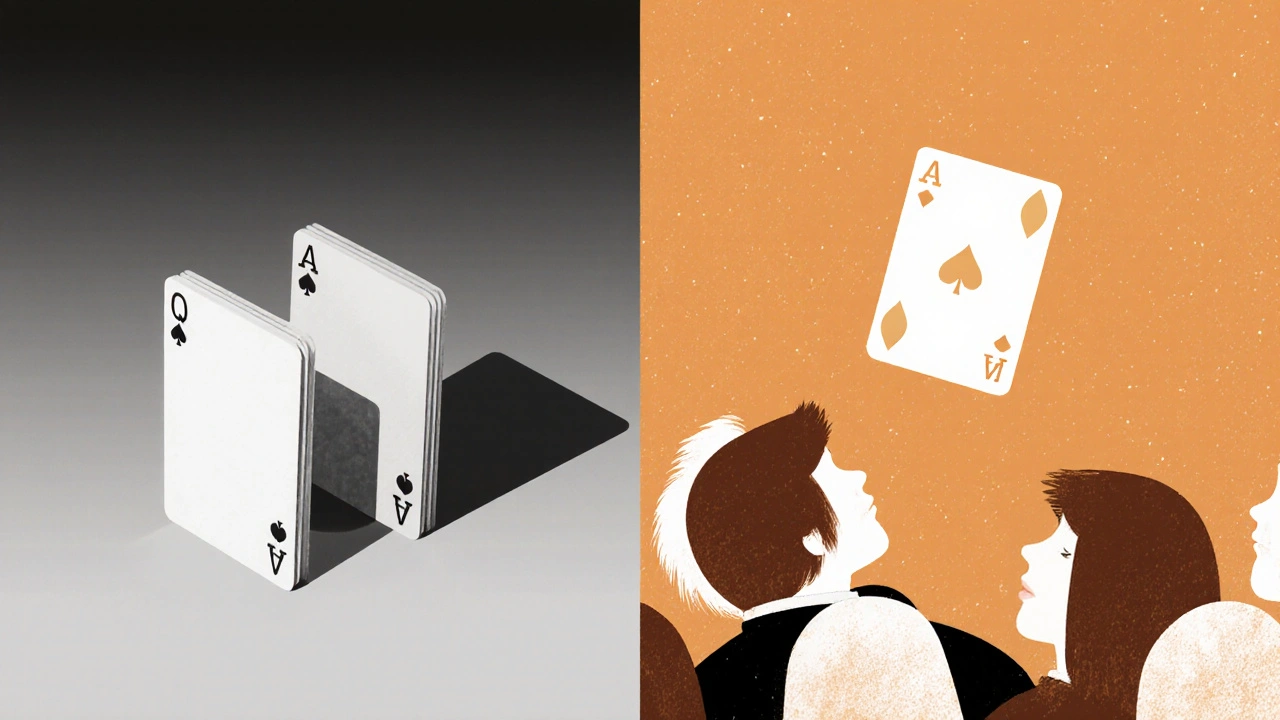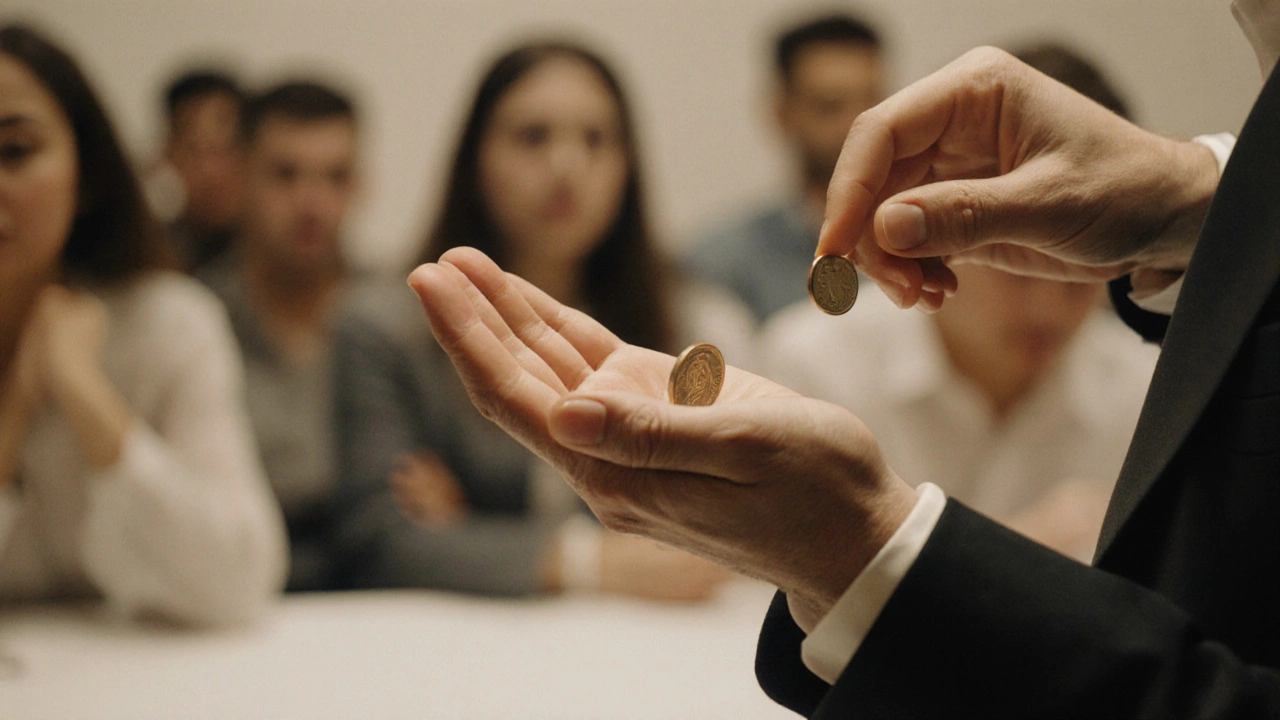When you hear the word flash in magic, it doesn’t mean lightning or a camera burst. It’s a quiet, powerful term magicians use to describe a move that’s so fast, clean, and invisible that the audience doesn’t even realize something happened. It’s not just speed-it’s precision disguised as nothing at all.
Flash isn’t about speed-it’s about misdirection
Many beginners think flash means doing something really fast. But speed alone doesn’t make a flash. You can wave a card under someone’s nose at 100 miles per hour and they’ll still see it if your timing or focus is off. True flash happens when the audience’s attention is pulled away, and the secret move slips in like a shadow.Think of it like this: you’re watching a magician pull a coin from your ear. You’re focused on his hand near your head. But while your eyes are there, his other hand-hidden behind his back-palmed the coin a full second earlier. That’s flash. The coin vanished before you even blinked. The move itself was slow, controlled, and silent. But because your mind was elsewhere, you didn’t catch it.
How flash works in real magic routines
Flash is the secret behind some of the most famous effects in magic. Take the classic Ambitious Card routine. A spectator picks a card, puts it back in the deck, and the magician makes it rise to the top-over and over. How? One of the most common methods uses a flash: the magician uses a simple double lift (lifting two cards as one) and then uses a slight finger shift to make the top card look like the chosen one. The whole thing takes less than half a second. The audience sees the card “rise,” but they never see the actual switch. That’s flash.Another example: the French Drop. A coin is shown in the right hand. The magician closes the hand, pretends to transfer the coin to the left, and opens the right hand-empty. The coin is still there, hidden in the palm. The hand movement is quick, but not crazy fast. What makes it work is the slight head turn, the eye contact, and the natural motion of the left hand reaching out. The audience believes they saw the coin leave. They didn’t. That’s flash.
Flash vs. other magic techniques
Not every quick move is flash. Here’s how it differs from other terms you might hear:- Palming: Holding an object secretly in your hand. Flash often uses palming, but palming alone isn’t flash.
- Sleight of hand: A broad term for any manual trick. Flash is a type of sleight, but not all sleights are flash.
- Misdirection: Drawing attention away. Flash relies on misdirection, but misdirection doesn’t always involve a physical move.
- Production: Making something appear. Flash is usually about disappearance or switch, not creation.
Flash is the quiet assassin of magic. It doesn’t shout. It doesn’t dazzle. It just… happens.

Why flash matters more than ever
In today’s world, people have seen everything. YouTube tutorials, TikTok magic hacks, smartphone slow-mo cameras-audiences are sharper. If you rely on flashy moves with big gestures, they’ll catch you. But flash? Flash survives because it doesn’t look like magic. It looks like a normal hand movement, a casual glance, a natural pause.Top magicians like David Blaine and Dynamo don’t do tricks with smoke and mirrors. They do flash. A card vanishes as they reach for their pocket. A coin disappears while they’re talking about the weather. No music. No lights. Just a quiet moment where something impossible happens-and no one knows how.
How to practice flash
Flash isn’t something you learn overnight. It’s built over months of repetition and observation. Here’s how to start:- Start slow. Practice the move at 10% speed. Focus on perfect finger placement, not speed. If you can’t do it cleanly at slow motion, you won’t do it cleanly at full speed.
- Use a mirror. Watch your own eyes. Where do you look when you do the move? Most people look at their hand. That’s a giveaway. Learn to look at the audience instead.
- Record yourself. Film your practice from the audience’s perspective. Watch it back. If you can see the move, your audience can too.
- Practice with distraction. Talk while you do it. Hum. Ask someone a question. If the move still works while you’re distracted, you’ve got flash.
- Test on real people. Don’t practice on friends who know you’re a magician. Try it on strangers. If they say, “Wait, how did you do that?” you haven’t succeeded yet. If they say, “Huh, cool,” and move on-you’ve nailed it.

Common flash mistakes beginners make
Even experienced magicians mess up flash. Here are the top three mistakes:- Overdoing it. Trying to make every move a flash. Flash works because it’s rare. If every trick has a flash, none of them stand out.
- Ignoring timing. Flash isn’t about how fast you move-it’s about when you move. A millisecond too early or too late ruins it.
- Not matching the story. If you’re telling a story about a lost ring, and you do a flash to make it vanish, the audience needs to feel the emotion. If the flash feels mechanical, it breaks the spell.
Flash in modern magic: beyond cards and coins
Flash isn’t just for cards and coins. It’s used in mentalism, escape acts, and even street magic. A mentalist might flash a thought into a spectator’s mind by subtly guiding their focus during a conversation. An escape artist might flash a lock pick into their hand while pretending to tie a knot. Even in digital magic-like apps that make objects disappear on screen-the same principle applies: the user’s attention is led away while the algorithm does its work.The core idea stays the same: make the impossible look ordinary. That’s flash.
What to learn next
If you want to master flash, start with these three foundational moves:- Double lift (for cards)
- French Drop (for coins)
- Classic Palm (for small objects)
Practice one of these for 15 minutes a day for 30 days. Don’t move on until you can do it without thinking. Then record yourself and test it on someone who’s never seen magic before. If they don’t catch it-you’re getting close.
Is flash the same as a sleight of hand?
Flash is a type of sleight of hand, but not all sleights are flash. Sleight of hand is the broad category of manual magic techniques. Flash is a specific style within that-where the move is so smooth and timed perfectly that the audience doesn’t notice it happened at all.
Can flash be used with everyday objects?
Absolutely. Flash works best with everyday items like coins, keys, pens, or even a napkin. The more normal the object, the less suspicious the move. That’s why flash is so powerful-it turns ordinary moments into magic.
Do I need special tools to do flash?
No. Flash doesn’t require gimmicks, magnets, or hidden devices. It’s all about your hands, timing, and how you guide attention. The best flash moves use nothing but your fingers and your ability to distract.
Why do some magicians say flash is outdated?
They’re wrong. Flash isn’t outdated-it’s essential. In an age where people film everything, flashy tricks with loud music and smoke are easy to decode. Flash survives because it looks real. It doesn’t scream “magic.” It whispers it.
How long does it take to learn flash?
It depends. You can learn the basics of one flash move in a few weeks with daily practice. But mastering it-making it invisible to real audiences-can take years. The difference between good and great isn’t speed. It’s consistency under pressure.


allison berroteran
November 16, 2025 AT 21:50Flash is one of those things that feels like magic because it doesn’t look like magic at all. I’ve watched people do card tricks for years and never realized how much of it is about where you’re not looking. It’s not speed-it’s psychology. The way your brain fills in gaps, how it assumes continuity… that’s what makes flash work. I think about it like how we miss things in daily life-like when someone changes their hairstyle and you don’t notice until someone points it out. Same principle. The brain doesn’t record everything. Magicians just exploit that.
It’s kind of beautiful, really. Magic isn’t about tricking people. It’s about letting them believe they saw everything, even when they didn’t. That’s trust. That’s art.
I’ve tried practicing the French Drop for weeks. Still can’t do it without looking at my hand. But I love that it’s not about perfection-it’s about making the audience forget they’re being watched. That’s the real skill.
And yeah, in a world of slow-mo videos and TikTok breakdowns, flash is the only thing that still works. People can’t catch what they didn’t see happen.
I wonder if this applies to life too. Like, the things we miss because we’re focused on the wrong thing. Maybe we’re all doing flash moves on each other every day.
Anyway. Still trying to get my double lift clean. 15 minutes a day. No excuses. Maybe next month I’ll actually fool my cat.
Jen Kay
November 17, 2025 AT 15:09Oh, so that’s what flash is. I thought it was just a fancy word for ‘sleight of hand’-turns out I’ve been using the wrong term for a decade. Thanks for the clarity.
And yes, David Blaine doesn’t need smoke and mirrors. He needs silence and a raised eyebrow. That’s the real power move.
Also, the part about testing on strangers? Brilliant. I’ve been practicing on my nephew-he’s 8. He screams ‘I saw it!’ every time. I think he’s a future detective. Or a magician. Probably both.
Michael Thomas
November 18, 2025 AT 11:09Flash? That’s just lazy magic. Real magic needs flair. You want to impress people? Do big stuff. Don’t whisper your tricks. Shout them. That’s how you win.
And no, I don’t care about YouTube. Real men don’t need slow-mo to prove they’re good.
Abert Canada
November 19, 2025 AT 16:38Man, this is actually one of the most thoughtful pieces on magic I’ve read in years. I’m from Canada and we don’t always get the spotlight, but I’ve been doing close-up magic at coffee shops in Vancouver for years. Flash is everything.
Used to think I needed gimmicks. Then I started using pens and napkins. People lose their minds. Not because it’s flashy. Because it’s quiet. One guy asked me if I was a spy after I made his coffee stirrer vanish. I said ‘No, just bad at stirring.’ He laughed. That’s the win.
Also, the mirror tip? Life-changing. I used to stare at my fingers like I was checking for dirt. Now I look at the person’s nose. Weird, but it works.
And yeah, I’ve tested on tourists. No one says ‘how?’ anymore. They just say ‘huh’ and walk away. That’s the goal. That’s the art.
Xavier Lévesque
November 21, 2025 AT 09:23Flash is just magic’s version of gaslighting. You make people doubt their own eyes because you’re better at controlling attention than they are at paying it. Cool. I get it.
But honestly? I’m more impressed by the fact that people still believe in it. Like, we live in a world where AI can generate any image, yet we still get weirded out when a coin disappears from a hand. That says more about us than the magician.
Also, the ‘practice with distraction’ thing? I tried it while yelling at my dog. He didn’t notice the coin. Neither did I. So I guess I’m ready for the next level.
Thabo mangena
November 21, 2025 AT 11:29Esteemed author, your exposition on the phenomenon of flash in magical practice is nothing short of luminous. In my homeland of South Africa, where oral tradition and subtle artistry have long been the bedrock of storytelling, the concept you articulate resonates with profound depth.
Flash, as you so elegantly describe, is not mere sleight, but a sacred alignment of intention, timing, and psychological harmony. It mirrors the silent gestures of elders who, without uttering a word, convey entire histories through a glance.
I have observed street magicians in Cape Town employ flash with astonishing grace-using only a piece of fruit or a button from a child’s shirt. The audience, often impoverished, does not demand spectacle. They crave wonder. And flash, in its quiet dignity, delivers it.
May I humbly suggest that your work be translated into isiZulu and Xhosa? The wisdom here transcends borders. It is not merely magic. It is humanity.
Karl Fisher
November 21, 2025 AT 15:54Okay, but let’s be real-flash is just magic for people who are too scared to do real magic. Like, if you can’t make a car disappear or levitate a person, you just whisper a card trick and call it ‘art.’
I’ve seen David Blaine do this exact thing. He looks at his watch. The card’s gone. Big whoop. I’ve done better with a deck and a mirror and zero training.
Also, why is everyone so obsessed with ‘not being seen’? Magic should be loud. It should be theatrical. It should make people scream. Not say ‘huh’ and go back to scrolling.
And don’t even get me started on ‘practice with distraction.’ That’s not magic. That’s a cognitive psychology experiment. And I’m not paying $50 to see a lab report.
Buddy Faith
November 23, 2025 AT 15:33Flash is just a word for when you’re bad at sleight and you blame the audience
People think they’re smart but they’re not
Watch a kid do a trick with a candy wrapper and they’ll see it in 2 seconds
Flash is a lie for adults who don’t want to admit they got fooled
Also I saw the double lift on my third try
Stop pretending it’s deep
Scott Perlman
November 24, 2025 AT 04:11I tried the French Drop yesterday. Didn’t work. But my dog looked at me like I was a genius. So I count it as a win.
Also I used a penny. Not a coin. A penny. And it still worked. So maybe flash doesn’t need fancy stuff.
Just practice. And don’t look at your hand.
That’s it.
Sandi Johnson
November 24, 2025 AT 18:41Wow. So flash is just misdirection with better PR. You didn’t invent anything. You just gave a fancy name to what magicians have been doing since the 1800s.
Also, ‘test on strangers’? I did that last week. My barista said ‘you’re good’ and gave me a free latte. That’s not magic. That’s customer service.
But hey. If it makes you feel like a wizard, go for it.
Just don’t call it art. Call it a party trick with a thesaurus.